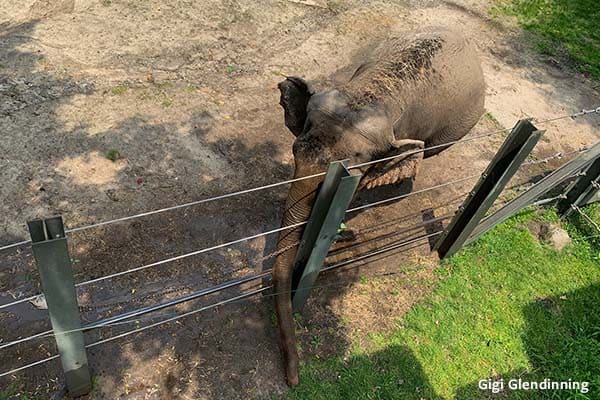
Ricky Gervais and Moby Call for Elephant Release
In Defense of Animals’ respected annual list of the 10 Worst Zoos for Elephants in North America has exposed suffering and markers of captivity-caused brain damage, even at accredited zoos which are considered to be the best. The Bronx Zoo is on the list at #5 for depriving elephants of their right to be happy. Ricky Gervais and Moby are calling for the elephants to be released to accredited sanctuaries.
Discover the list: www.idausa.org/2021worstzoolist
“The slightly over one acre outdoor enclosure was split in half with barriers, so both Patty and Happy can be outside at the same time safely,” said Brittany Michelson, Captive Animals Campaigner for In Defense of Animals. “It remains to be seen what the result of the court challenge will be, but Happy’s sad plight is a wake-up call that elephants suffer tremendously in zoos. Happy deserves the right to happiness and freedom at an accredited sanctuary.”
This is the 10th time the Bronx Zoo has made the 10 Worst Zoos list. The reason can be summed up by Happy’s unhappy story, which is now making headlines worldwide, in an historic first-ever court battle for elephant rights.
In October 2018, the Nonhuman Rights Project filed a petition for a common-law writ of habeas corpus in the New York Supreme Court, Orleans County, demanding recognition of Happy’s legal personhood and fundamental right to bodily liberty and her release to an elephant sanctuary.
What is the best situation for a half-century-old elephant to live out her golden years? Certainly not dividing her time between cramped indoor quarters and a half-acre outdoor enclosure, separated by a barrier from another elephant. Sadly, this is an upgrade from Happy’s previous life at the Bronx Zoo, where she was kept indoors most of the time so the other two elephants, Patty and Maxine, could be displayed for public entertainment.
Bob Jacobs, Ph.D., a professor of neuroscience at Colorado College said, “in their native habitats these animals must move to survive, covering great distances to forage or find a mate. Elephants typically travel anywhere from 15 to 120 miles per day. In a zoo, they average three miles daily, often walking back and forth in small enclosures.”
Happy was traumatized by witnessing the brutal attack and killing of her friend Grumpy by Patty and Maxine. Her vital need for social companionship has been entirely and insensitively brushed aside by the zoo ever since. Happy was not separated because she “can’t be with other elephants,” and “she does not get along with them,” yet these false claims were made in a recent Animal Planet show.
Happy and Grumpy were born in 1971 in Thailand and brought to the Bronx Zoo in 1973. They lived together until the fatal attack on Grumpy, who was euthanized by the zoo in 2002. Happy was kept separated from the other two for safety reasons. Since then, she has been forced to live mostly in solitary confinement indoors, due to the bitterly cold New York winters, or because the other elephants were used in the outdoor enclosure to draw the crowds to the zoo. Lack of space, social companions, and proper climate all lead to stress-causing brain damage in elephants.
The zoo brought in a young elephant, Sammie, to be with Happy, and it worked out well until Sammie was euthanized due to kidney failure in 2005. The deaths of her friends and her subsequent loneliness have caused Happy to suffer greatly. A study in 2006 reported that Happy successfully passed the mirror self-recognition test. Happy proved that elephants are not only vastly intelligent but also self-aware, which is thought to correlate with higher forms of empathy and altruistic behavior. Happy’s reward for her contribution to science has been 16 years of solitary confinement in which she is poignantly self-aware of her own bleak and lonely existence.
Right after Sammie’s death and the publication of the self-awareness study, the Bronx Zoo announced plans to close the elephant exhibit when one or more of the inhabitants died. Since that announcement, Maxine died in 2018. The slightly over 1-acre outdoor enclosure was split in half with barriers, so both Patty and Happy can be outside at the same time. But so far, no steps have been taken to make good on the promise to close the elephant exhibit.
According to AZA standards, each zoo with elephants must have a minimum of three females (or the space to have three females), two males, or three elephants of mixed gender. The Bronx Zoo fails to meet these bare-minimum requirements for elephant wellbeing.
Former elephant keeper and renowned elephant consultant Les O’Brien explains, “the areas that zoos provide elephants are too small for a family of meerkats let alone elephants. In human terms, the captive enclosure for elephants would be equivalent to a small family of humans living their entire life in a bathroom. Every qualified researcher on the planet agrees: no zoo environment is large enough or rich enough for the complex needs of elephants.”
“Year after year, our research finds more ways elephants suffer in zoos,” said Marylin Kroplick, M.D., President of In Defense of Animals. “Keeping elephants in zoos causes brain damage. Zoos imprison elephants for nothing more than profit and entertainment, which is unforgivable. We call on all zoos to commit to phasing out their exhibits and sending their elephants to accredited sanctuaries where they can live a much more natural life.”
10 Worst Zoos in 2021:
- Edmonton Valley Zoo, Edmonton, Alberta
- ABQ BioPark, Albuquerque, N.M.
- Cincinnati Zoo & Botanical Garden, Cincinnati, Ohio
- Phoenix Zoo, Phoenix, Ariz.
- Bronx Zoo, New York City
- Oklahoma City Zoo, Oklahoma City, Okla.
- Toledo Zoo & Aquarium, Toledo, Ohio
- Los Angeles Zoo, Los Angeles, Calif.
- Fresno Chaffee Zoo, Fresno, Calif.
- Audubon Zoo, New Orleans, La.





